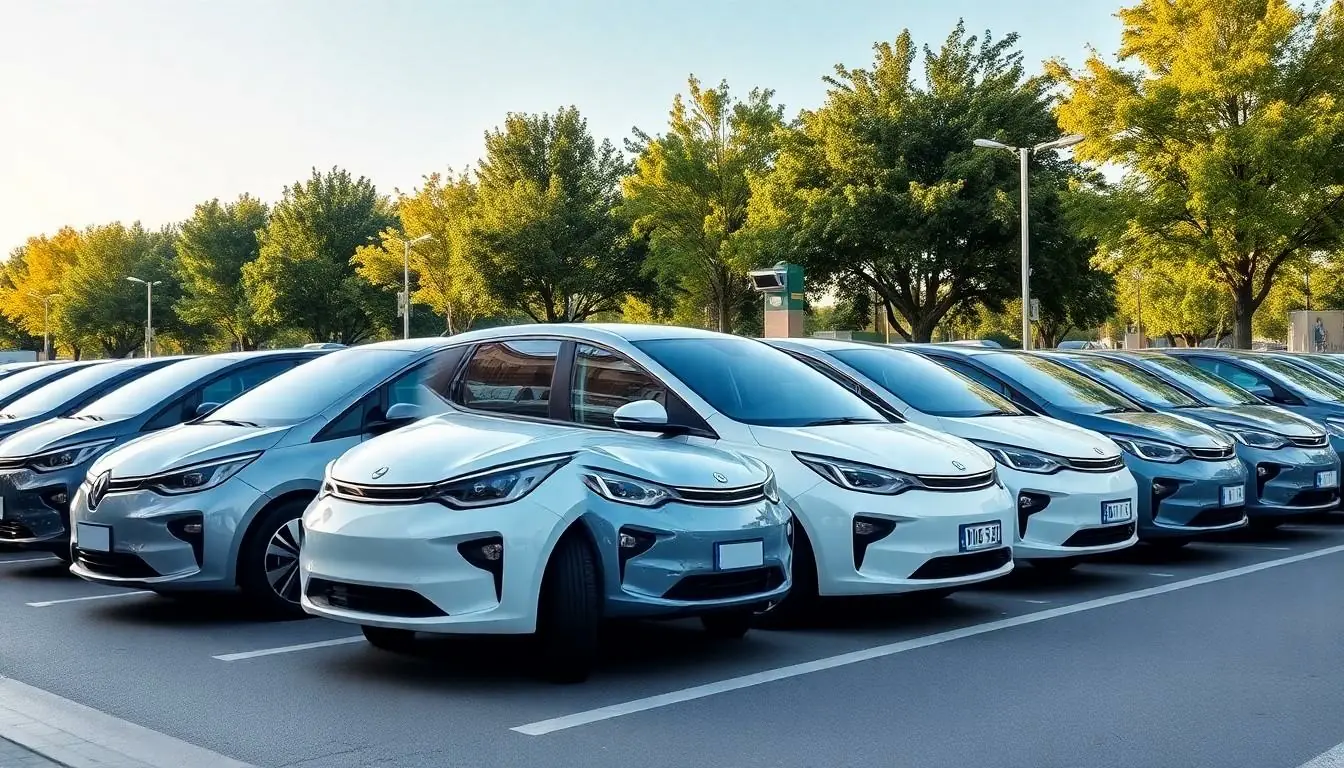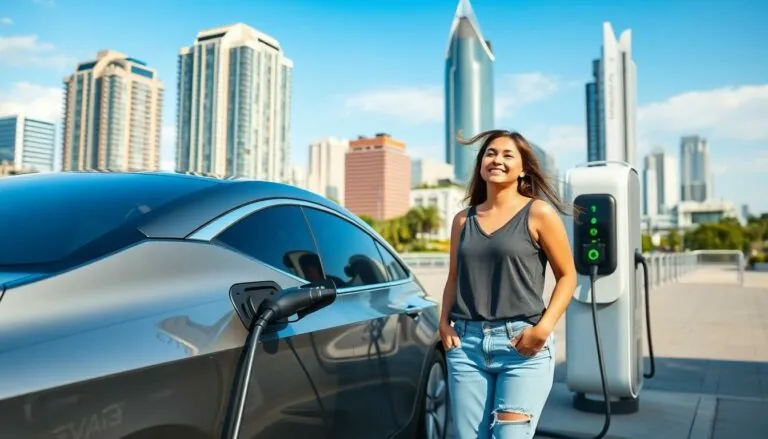Table of Contents
ToggleIn a world where gas prices soar higher than a kite on a windy day, electric vehicles (EVs) are zooming in to save the day. Imagine a fleet of sleek, silent cars gliding effortlessly down the road, all while giving Mother Earth a much-needed hug. With advancements in technology and a growing commitment to sustainability, businesses are trading in their gas guzzlers for a greener, cleaner future.
Overview Of Electric Vehicles Fleet
Electric vehicles (EVs) fleets represent a transformative shift in transportation. Companies increasingly adopt fleets to lower emissions and reduce fuel costs. These fleets consist of various EV models, including sedans, vans, and trucks. Organizations can customize their choices based on operational needs and range requirements.
Cost savings play a significant role in the transition to electric fleets. Studies show businesses can save between 50% to 70% on fuel and maintenance costs with EVs compared to traditional vehicles. Fleet electrification also aligns with corporate sustainability goals, enhancing brand reputation.
Technological advancements fuel the growth of electric vehicle fleets. High-capacity batteries offer extended ranges, making long-distance travel viable. Additionally, advancements in charging infrastructure make it easier to recharge vehicles efficiently. Rapid charging stations are becoming more accessible, allowing for quick refueling during downtime.
Government incentives encourage companies to adopt electric fleets. Tax credits and rebates significantly reduce the upfront costs of purchasing electric vehicles. These incentives help make transitioning more financially feasible for businesses.
Logistics and distribution industries particularly benefit from electric vehicles. Fleet managers find EVs suitable for urban operations, where lower emissions improve air quality. Integration of electric vehicles often leads to reduced noise pollution, creating a better environment for employees and communities.
Overall, electric vehicles fleets are a smart investment. Benefits include reduced operating costs, improved sustainability, and alignment with regulatory requirements. Individuals and businesses are motivated to join the electric movement, contributing to a cleaner, more sustainable future.
Benefits Of Electric Vehicles Fleet

Electric vehicle fleets provide significant advantages for businesses, particularly in environmental sustainability and operational cost efficiency.
Environmental Impact
Environmental benefits are substantial with electric vehicle fleets. They help reduce greenhouse gas emissions significantly, contributing to cleaner air in urban centers. Improvements in air quality become evident as these vehicles operate with zero tailpipe emissions. Studies show that transitioning to electric fleets can reduce CO2 emissions by up to 70% compared to traditional vehicles. In addition, electric vehicles lower noise pollution levels, enhancing the quality of life for nearby residents. Utilizing renewable energy sources for charging further amplifies these environmental gains, aligning fleet operations with broader climate goals.
Cost Savings
Cost savings present a compelling case for electric vehicle fleets. Businesses can achieve fuel savings ranging from 50% to 70% compared to conventional gas-powered vehicles. Expenses related to maintenance decrease significantly, as electric vehicles have fewer moving parts and require less frequent service. Operational efficiency improves due to the predictable energy costs associated with electric charging. Government incentives, including tax credits and rebates, enhance the financial appeal of transitioning fleets to electric. Businesses can expect a quicker return on investment through reduced overall expenses, creating a sustainable financial model for future operations.
Challenges Facing Electric Vehicles Fleet
Electric vehicles fleets face several challenges that can impede their growth. Addressing these obstacles is crucial for maximizing the benefits of electric vehicle integration in businesses.
Infrastructure Limitations
Charging infrastructure remains a significant barrier to the widespread adoption of electric vehicle fleets. Many regions lack sufficient charging stations, leading to range anxiety among fleet operators. Availability varies by location, making it challenging for companies to plan routes effectively. Organizations may find it difficult to scale their EV fleets without a robust charging network. Insufficient infrastructure can also result in increased downtime for vehicles, limiting operational efficiency. Developing more widespread charging options is essential for supporting fleet expansion and utilization.
Technological Barriers
Technological barriers inhibit the full potential of electric vehicle fleets. Battery performance plays a crucial role in vehicle range and efficiency. Advances in battery technology have improved dramatically, but the need for longer-lasting batteries continues. Fleet operators may encounter limitations with charging speeds, affecting turnaround times. Additionally, software issues related to vehicle management can complicate operations. Integrating these technologies seamlessly into existing systems presents another challenge. Addressing these technological concerns is vital for optimizing the efficiency of electric vehicle fleets.
Case Studies Of Electric Vehicles Fleet
Various organizations successfully demonstrate the potential of electric vehicle fleets. These case studies highlight operational efficiencies, cost savings, and environmental benefits.
Successful Implementations
Companies like UPS and Amazon adopted electric vehicles for their logistics operations. UPS has incorporated over 10,000 electric delivery vehicles, significantly reducing emissions. Amazon plans to deploy 100,000 electric vans, targeting carbon neutrality by 2040. Tesla’s all-electric semi trucks are utilized by businesses for regional deliveries, enhancing overall performance while minimizing fuel costs. Municipalities, such as Los Angeles, have transitioned their bus fleets to electric, contributing to local air quality improvements. Studies reveal that organizations can save between 50% and 70% on fuel and maintenance by shifting to electric models.
Lessons Learned
Fleet operators encountered several challenges when adopting electric vehicles. Insufficient charging infrastructure presented a major obstacle, quickly resolved through strategic partnerships with charging network providers. Additionally, data showed that operational training was essential for drivers to maximize electric vehicle efficiency. Moreover, battery life presented a concern, prompting companies to invest in more advanced technologies. Learning from these experiences helped organizations better understand the importance of integrating charging solutions into daily operations. Continuous development and adaptation remain critical for optimizing electric fleet performance and realizing substantial cost savings.
Future Trends In Electric Vehicles Fleet
The future of electric vehicle fleets showcases significant advancements and emerging trends. Battery technology is evolving, resulting in longer-lasting batteries and faster charging capabilities. Companies are prioritizing partnerships with charging infrastructure providers to facilitate seamless integration of EVs.
Fleet operators increasingly leverage data analytics for optimizing routes, reducing energy consumption, and enhancing operational efficiency. Automation and artificial intelligence play crucial roles in managing electric fleets, allowing for smarter logistics solutions.
Another trend includes sustainability certifications that recognize organizations committing to green initiatives. Businesses adopting electric fleets are likely to see advantages in public perception and customer loyalty. Electric vehicle manufacturers are also launching models designed specifically for various commercial applications.
Government support is becoming more robust, providing additional incentives and funding opportunities. Financial models are emerging to ease the transition. Leasing options and group purchasing agreements reduce upfront costs, making electric fleets more appealing to a broader range of businesses.
Moreover, urban planners are emphasizing electric vehicles in their smart city initiatives, promoting eco-friendly transportation options. The push for clean energy sources is creating synergies across industries, resulting in collaborative efforts and advancements in technology.
As adoption rates increase, a focus on recycling and repurposing batteries will elevate the lifecycle management of electric fleets. Overall trends indicate a rapid evolution in electric vehicle integration, driving significant progress toward a more sustainable future in fleet operations.
The shift towards electric vehicle fleets represents a pivotal moment for businesses aiming to enhance sustainability and reduce operational costs. As technology advances and charging infrastructure improves, the viability of electric fleets continues to grow. Companies can expect significant savings on fuel and maintenance while contributing to a cleaner environment.
With increasing government support and successful case studies demonstrating the benefits, the transition to electric vehicles is not just a trend but a strategic move for future growth. Addressing the challenges of infrastructure and technology will be crucial in maximizing the potential of electric fleets. Embracing this evolution will position businesses at the forefront of sustainability and operational efficiency.




